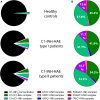Patterns of C1-Inhibitor/Plasma Serine Protease Complexes in Healthy Humans and in Hereditary Angioedema Patients
- PMID: 32431708
- PMCID: PMC7214733
- DOI: 10.3389/fimmu.2020.00794
Patterns of C1-Inhibitor/Plasma Serine Protease Complexes in Healthy Humans and in Hereditary Angioedema Patients
Abstract
C1-inhibitor (C1-INH) is an important regulator of the complement, coagulation, fibrinolytic and contact systems. The quantity of protease/C1-INH complexes in the blood is proportional to the level of the in vivo activation of these four cascade-like plasma enzyme systems. Parallel determination of C1-INH-containing activation complexes could be important to understand the regulatory role of C1-INH in diseases such as hereditary angioedema (HAE) due to C1-INH deficiency (C1-INH-HAE). We developed in-house ELISAs to measure the concentration of complexes of C1-INH formed with active proteases: C1r, C1s, MASP-1, MASP-2, plasma kallikrein, factor XIIa, factor XIa, and thrombin, as well as to determine total and functionally active C1-INH. We measured the concentration of the complexes in EDTA plasma from 6 healthy controls, from 5 with type I and 5 with type II C1-INH-HAE patients during symptom-free periods and from five patients during HAE attacks. We also assessed the concentration of these complexes in blood samples taken from one C1-INH-HAE patient during the kinetic follow-up of a HAE attack. The overall pattern of complexed C1-INH was similar in controls and C1-INH-HAE patients. C1-INH formed the highest concentration complexes with C1r and C1s. We observed higher plasma kallikrein/C1-INH complex concentration in both type I and type II C1-INH-HAE, and higher concentration of MASP-1/C1-INH, and MASP-2/C1-INH complexes in type II C1-INH-HAE patients compared to healthy controls and type I patients. Interestingly, none of the C1-INH complex concentrations changed significantly during HAE attacks. During the kinetic follow-up of an HAE attack, the concentration of plasma kallikrein/C1-INH complex was elevated at the onset of the attack. In parallel, C1r, FXIIa and FXIa complexes of C1-INH also tended to be elevated, and the changes in the concentrations of the complexes followed rather rapid kinetics. Our results suggest that the complement classical pathway plays a critical role in the metabolism of C1-INH, however, in C1-INH-HAE, contact system activation is the most significant in this respect. Due to the fast changes in the concentration of complexes, high resolution kinetic follow-up studies are needed to clarify the precise molecular background of C1-INH-HAE pathogenesis.
Keywords: C1-inhibitor; HAE attack; activation; hereditary angioedema; kinetic follow-up; serine protease.
Copyright © 2020 Kajdácsi, Jandrasics, Veszeli, Makó, Koncz, Gulyás, Köhalmi, Temesszentandrási, Cervenak, Gál, Dobó, de Maat, Maas, Farkas and Varga.
Figures




Similar articles
-
The role of ficolins and MASPs in hereditary angioedema due to C1-inhibitor deficiency.Mol Immunol. 2013 Jul;54(3-4):271-7. doi: 10.1016/j.molimm.2012.12.015. Epub 2013 Jan 12. Mol Immunol. 2013. PMID: 23318225
-
The Levels of the Lectin Pathway Serine Protease MASP-1 and Its Complex Formation with C1 Inhibitor Are Linked to the Severity of Hereditary Angioedema.J Immunol. 2015 Oct 15;195(8):3596-604. doi: 10.4049/jimmunol.1402838. Epub 2015 Sep 14. J Immunol. 2015. PMID: 26371246 Clinical Trial.
-
A novel assay to diagnose hereditary angioedema utilizing inhibition of bradykinin-forming enzymes.Allergy. 2015 Jan;70(1):115-9. doi: 10.1111/all.12520. Epub 2014 Oct 15. Allergy. 2015. PMID: 25186184
-
The importance of recognizing and managing a rare form of angioedema: hereditary angioedema due to C1-inhibitor deficiency.Postgrad Med. 2021 Aug;133(6):639-650. doi: 10.1080/00325481.2021.1905364. Epub 2021 Jul 6. Postgrad Med. 2021. PMID: 33993830 Review.
-
Pathogenic mechanisms of bradykinin mediated diseases: dysregulation of an innate inflammatory pathway.Adv Immunol. 2014;121:41-89. doi: 10.1016/B978-0-12-800100-4.00002-7. Adv Immunol. 2014. PMID: 24388213 Review.
Cited by
-
Complement Activation in the Central Nervous System: A Biophysical Model for Immune Dysregulation in the Disease State.Front Mol Neurosci. 2021 Mar 4;14:620090. doi: 10.3389/fnmol.2021.620090. eCollection 2021. Front Mol Neurosci. 2021. PMID: 33746710 Free PMC article.
-
"Super" SERPINs-A stabilizing force against fibrinolysis in thromboinflammatory conditions.Front Cardiovasc Med. 2023 Apr 19;10:1146833. doi: 10.3389/fcvm.2023.1146833. eCollection 2023. Front Cardiovasc Med. 2023. PMID: 37153474 Free PMC article. Review.
-
Molecular Basis for Bordetella pertussis Interference with Complement, Coagulation, Fibrinolytic, and Contact Activation Systems: the Cryo-EM Structure of the Vag8-C1 Inhibitor Complex.mBio. 2021 Mar 23;12(2):e02823-20. doi: 10.1128/mBio.02823-20. mBio. 2021. PMID: 33758081 Free PMC article.
-
Insights into the pathogenesis of hereditary angioedema using genetic sequencing and recombinant protein expression analyses.J Allergy Clin Immunol. 2023 Apr;151(4):1040-1049.e5. doi: 10.1016/j.jaci.2022.11.027. Epub 2022 Dec 29. J Allergy Clin Immunol. 2023. PMID: 36587848 Free PMC article.
-
Distinction of early complement classical and lectin pathway activation via quantification of C1s/C1-INH and MASP-1/C1-INH complexes using novel ELISAs.Front Immunol. 2022 Nov 4;13:1039765. doi: 10.3389/fimmu.2022.1039765. eCollection 2022. Front Immunol. 2022. PMID: 36420270 Free PMC article.
References
-
- Gregorek H, Kokai M, Hidvegi T, Fust G, Sabbouh K, Madalinski K. Concentration of C1 inhibitor in sera of healthy blood donors as studied by immunoenzymatic assay. Compl Inflamm. (1991) 8:310–2. - PubMed
Publication types
MeSH terms
Substances
LinkOut - more resources
Full Text Sources
Miscellaneous

